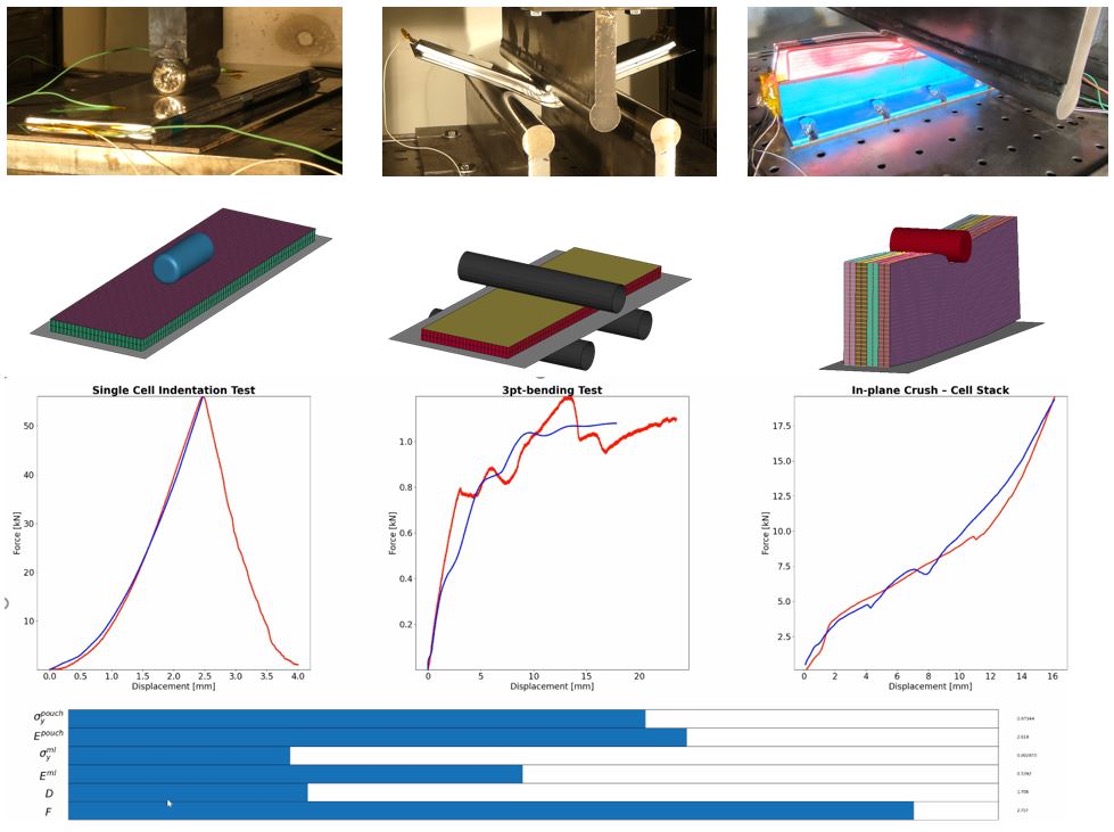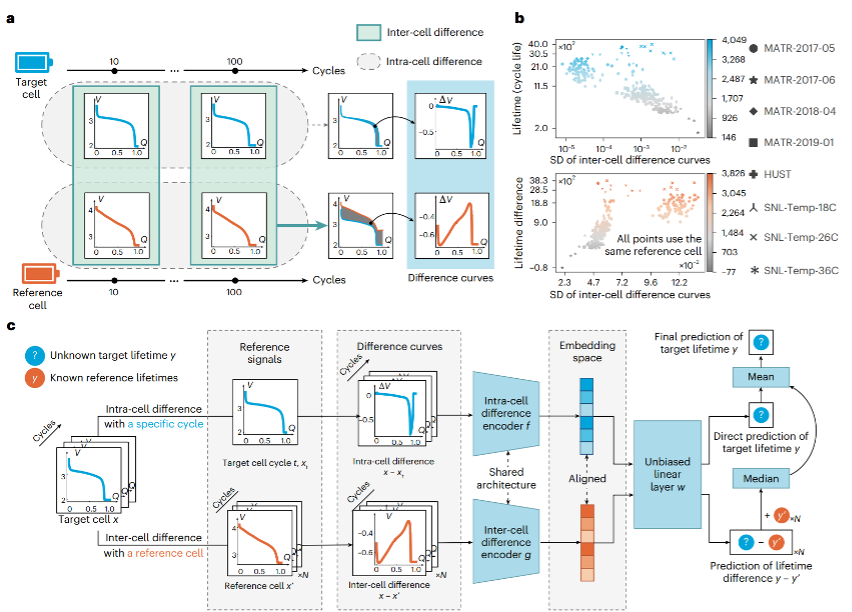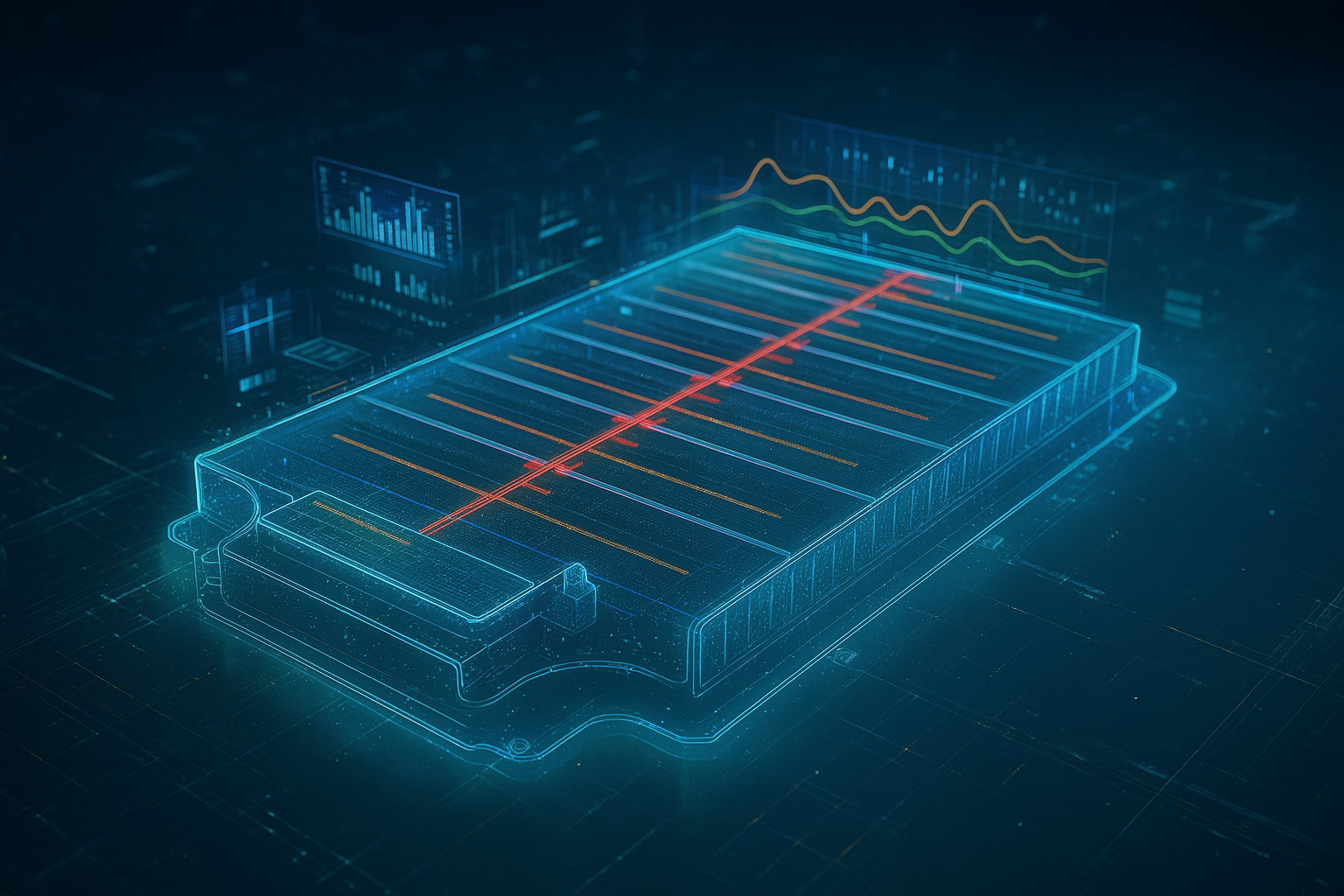Introduction
Designing and operating electric vehicles (EVs), particularly their battery systems, demands a rigorous understanding of multi-scale, multi-physics phenomena. Battery behavior is governed not only by macroscopic electrical signals like voltage and current, but also by internal electrochemical dynamics that evolve with temperature, aging, and usage patterns. Capturing these phenomena accurately requires high-fidelity, physics-based models—often rooted in electrochemistry and thermodynamics—that are computationally expensive and impractical for use in real-time applications.
This presents a fundamental challenge: how can we retain the predictive power of detailed physical models while enabling their use in fast, iterative design loops and in embedded systems for real-time control?
Digital twins, combining physics-based simulations and AI-driven surrogates, provide a compelling answer. By training machine learning models to emulate high-fidelity simulations or interpolate between them intelligently, we can build hybrid digital twins that bridge electrochemical battery models with observable quantities like voltage, current, and thermal load. These twins can then be embedded into system-level simulators—such as Modelica-based frameworks or FMI (Functional Mock-up Interface) standards—to support co-simulation and system integration, where batteries interact dynamically with the vehicle’s powertrain, thermal management, and control software.
This capability is essential not only for early-stage design optimization but also for enabling real-time monitoring, diagnostics, and predictive control during operation. With increasing demand for safety, reliability, and performance under a wide range of usage conditions, OEMs and suppliers need scalable tools that can compress development cycles while preserving physical fidelity.
The market evolution reflects this need for smarter, integrated modeling approaches. According to a 2025 Velox Consultants study, the global digital twin market is projected to reach, valued at $21.1billion in 2024, is projected to reach $119.8 billion by 2029, growing at a CAGR of 41.6%. This growth is distributed across various keystages of the digital twin development chain and, in particular, according to there port by Knowledge Sourcing Intelligence, the AI in simulation market is estimated to grow at a CAGR of 15.57%, attaining US $44.937 billion by 2029 from US $21.793 billion in 2024. Indeed, the integration of AI and simulation is accelerating: IDC forecasts that by 2026, at least 40% of digital twins will embed AI/ML for adaptive, real-time optimization.
On the demand side, the electric vehicle market is surging. The International Energy Agency (IEA) recorded over 14 million EVs globally in 2023, with annual sales projected to exceed 45 million by 2030, creating an urgent need for scalable battery and system modeling. McKinsey&Company forecasts that the global demand for lithium-ion battery cells will increase by factor 6, mainly driven by the mobility sector.
This white paper explores how hybrid AI/simulation digital twins can support the design, integration, and operation of EV battery systems—from detailed electrochemical modeling to real-time application within embedded vehicle simulations. By combining the strengths of physical modeling with the speed and adaptability of AI, these tools offer a path toward more efficient development and safer, more performant e-Mobility solutions.
Prediction and Optimization
To evaluate the behavior of lithium-ion battery cells under mechanical loads, numerical finite element simulations are used in addition to experiments. This is necessary to predict, in the vehicle development process, the deformations that batteries may experience in the event of a traffic accident. This ensures that safety requirements are met.
A critical aspect is that the simulation models of the battery cells must accurately represent real battery behavior while also being computationally efficient enough to be integrated into full-vehicle simulation models.
To achieve this, multiple parameters of the simulation models are calibrated against a variety of characteristic load case experiments. This model generation process can be time-consuming and may need to be repeated for different states, such as varying state of charges.
However, the application of data-driven methods, for example, as shown in Figure 1, can significantly accelerate this process and improve the transfer of experimental information into the virtual environment. [1–3]

Degradation Mechanism
It is well established that batteries degrade over their lifetime, resulting in a gradual loss of capacity. However, while the electrical effects of aging (such as reduced energy density and increased internal resistance) are widely documented, the impact on mechanical and thermal behavior remains relatively unexplored.
This knowledge gap is critical, as mechanical integrity and thermal stability are essential for safety, performance, and longevity. A key challenge in modeling these aging processes lies in their inherent complexity.
Degradation is influenced by a multitude of factors, including cycling conditions, temperature exposure, and mechanical loading. Moreover, these factors often interact in nonlinear ways, making it difficult to isolate individual degradation mechanisms.
To address this, large-scale field data can provide invaluable insights. By analyzing trends across diverse usage scenarios, researchers can identify patterns linking operational parameters to degradation modes. However, traditional analytical methods often struggle with the high dimensionality and interdependencies of such datasets.
This is where data-driven approaches, particularly artificial intelligence, offer potential. AI techniques can uncover hidden correlations in vast datasets, enabling predictive models that account for multifactorial aging processes.
Figure 2 illustrates a deep learning framework designed to predict battery lifetime across a wide range of aging conditions.
Panel a depicts the process of feature construction, where each cycle of battery usage is represented by the relationship between normalized capacity (Q) and voltage (V). This curve is encoded into a feature map that captures the battery’s electrochemical behavior over time.
Panel b shows the strength of correlation between these constructed features and the target outputs—remaining useful life or degradation indicators—for both intra-cell learning (using data from the same cell) in the upper half, and inter-cell learning (generalizing across different cells) in the lower half.
Panel c presents the architecture of the BatLiNet model, detailing how raw data flows through various layers of the network to extract patterns and generate accurate lifetime predictions. This architecture allows the model to capture nonlinear degradation behaviors and enables robust performance even under varied usage scenarios.

Monitoring and Failure Prognosis
Monitoring battery state is essential to optimize usage, manage loads, improve performance, extend service life, and, above all, ensure safety in both first and second life.
Accurate estimation of battery state enables predictive maintenance and timely replacements by detecting critical conditions and preventing catastrophic failures.
Battery degradation results from multiple mechanisms driven by the electrical, thermal, and mechanical loads experienced by the battery. Therefore, a single parameter is not sufficient to comprehensively describe the battery state.
Comprehensive monitoring must combine multiple measurements such as voltage, current, and temperature, with sensor placement and accuracy chosen to balance pack complexity and estimation accuracy.
Since cells of the same type can age differently due to varied duty cycles, traditional methods struggle to account for this variability and achieve accurate state estimation.
Data-driven models such as random forests, support vector machines, and neural networks can analyze large field datasets to uncover hidden relationships between parameter evolution and battery state.
The general hybrid digital twin framework is shown in Figure 3. A more detailed flowchart of battery state estimation based on data-driven models can be found in [6].
These models enable more accurate state estimation, providing a comprehensive understanding of battery state, guiding maintenance strategies and ultimately improving the performance, safety, and lifespan of battery systems.

Conclusion
At Duoverse, we believe that the fusion of physics-based modeling and AI-enabled surrogates is essential to unlocking the full potential of digital twins for battery systems in electric vehicles. From early-stage design and real-time embedded control to lifetime performance tracking and safety assurance, hybrid modeling approaches offer a scalable and accurate solution to the growing demands of the eMobility sector.
In collaboration with the Battery4Life GmbH, a COMET Center launching in 2025 in Austria, we are actively contributing to research aimed at improving the safety and sustainability of lithium-ion battery technologies. Battery4Life brings a unique systems-level perspective, not only advancing the technical understanding of battery behavior under critical conditions—such as crash scenarios or thermal events—but also integrating multidisciplinary research throughout the whole battery lifecycle, including reuse, 2nd life, or lifetime extension in general. This aligns with our mission at Duoverse: to develop lightweight, trustworthy digital twins that support better decision-making across the value chain—from cell design and system integration to second-life applications and recycling.
Together, we are building tools and insights that will help OEMs, suppliers, and researchers accelerate innovation while maintaining the highest standards of safety, performance, and sustainability in both mobile and stationary energy systems. By combining the strengths of simulation, AI, and domain expertise, we are shaping a smarter and more resilient battery future.
For further information about these topics, feel free to reach out at contact@duoverse.ai.
References
[1] A. Schmid, A.Pasquale, C. Ellersdorfer, V. Champaney, M. Raffler, S. Guévelou, S. Kizio, M.Ziane, F. Feist, and F. Chinesta, Pgd based meta modelling of a lithium-ionbattery for real time prediction, Frontiers in Materials (ComputationalMaterials Science), 10 (2023)
[2] A. Schmid, A.Pasquale, C. Ellersdorfer, M. Ziane, M. Raffler, V. Champaney, F. Feist, and F. Chinesta, Application of pgd separation of space to create a reduced-ordermodel of a lithium-ion cell structure, Frontiers in Materials, 10 (2023)
[3] A. Schmid, A.Pasquale, C. Ellersdorfer, M. Raffler, V. Champaney, M. Ziane, F. Feist, and F. Chinesta, Mechanical characterization of li-ion cells and the calibration ofnumerical models using proper generalized decomposition, InternationalMechanical Engineering Congress and Exposition (IMECE), October 29-November 2 (2023)
[4] A. Schmid, C.Ellersdorfer, M. Raffler, F. Feist, A. Pasquale, V. Champaney, S. Guévelou, M.Ziane, and F. Chinesta, Meta-modelling of a li-ion battery for real time prediction based on proper generalized decomposition, Advanced Materials PosterDay (Tu Graz), February 2 (2023)
[5] Zhang, H., Li, Y., Zheng, S. et al. Battery lifetime prediction across diverse ageing conditions with inter-cell deep learning. Nat Mach Intell 7, 270–277 (2025)
[6] Tao, J., Wang, S., Cao, W., Fernandez, C., & Blaabjerg, F. A Comprehensive Review of Multiple Physical and Data-Driven Model Fusion Methods for Accurate Lithium-Ion Battery Inner State Factor Estimation. Batteries, 10(12), 442 (2024)








